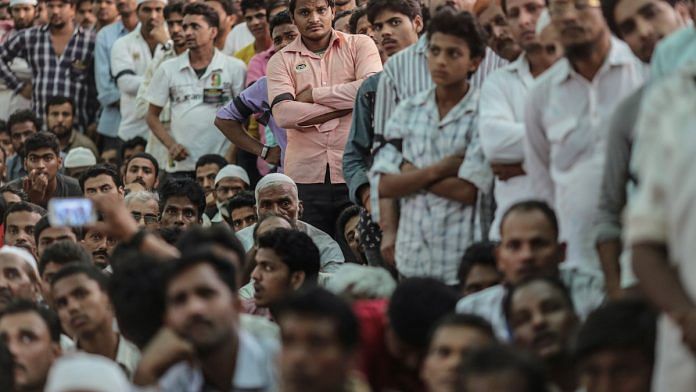
Thank you dear subscribers, we are overwhelmed with your response.
Your Turn is a unique section from ThePrint featuring points of view from its subscribers. If you are a subscriber, have a point of view, please send it to us. If not, do subscribe here: https://theprint.in/
The age-old debate about One nation One Language has once again been triggered. Our founding fathers were aware of the role that a common language could play in forging India into a nation. They knew that language barriers amongst people of the country posed a formidable challenge to the idea of a united India. Therefore, successive attempts made by successive central governments to secure a consensus on the concept of ‘One Nation One Language’ are not without merit. However, the architects of our nation also knew that linguistic identities tend to be quite rigid and any attempt to impose one language over our multi-lingual population would be met with fierce resistance. Therefore, our Constitution makers came up with a novel solution in the form of a language that would belong to all, i.e., a truly pan-Indian language.
This language was Hindi, not because it had the largest number of speakers, which is an additional benefit, but for its other more important and unique features. Hindi’s potential to serve as ‘The One’ language of India lied in its dynamic and evolving nature. Hindi was and still is a relatively young language, thus enabling it to grow as a ‘mixed language’, enriching its vocabulary with words from other Indian languages. Its shared similarities with so many Indian languages, is in itself a result of the assimilation of various local dialects prevalent in the Hindi heartland. It was further envisaged to extend its reach to the languages of South and East India, and other Scheduled Languages and thus strengthen its ‘Hindustani’ character, truly becoming the language of India. This is clearly enunciated in Article 351 of our Constitution:
It is the duty of the Union to promote the spread of the Hindi lang, to develop it so that it may serve as a medium of expression for all India and to secure its enrichment by assimilating, the forms, style and expressions used in Hindustani and in the other Scheduled languages, and by drawing, wherever necessary, for its vocabulary, primarily on Sanskrit and secondarily on other languages.
It is evident from the Article’s provisions that ‘Hindi’ was never supposed to be adopted as a language by non-Hindi speaking states, rather the onus was on Union to develop Hindi to be India’s lingua franca. Here, to define and limit the scope of assimilation, even a list of languages has been provided in the Eighth Schedule. Thus, this article is truly a testament to the great vision of our Constituent Assembly.
However, due to its primary emphasis on Sanskrit, unfortunately, Union Government and Hindi chauvinists have interpreted it as Sanskritization or purification of Hindi. Nothing could be farther from the truth as the Article’s reference to Sanskrit, actually is just an acknowledgement of the fact that most Indian languages today, either trace their roots to Sanskrit or have been considerably influenced by it, e.g., 80% of Telugu’s lexicon is derived from Sanskrit. This becomes more evident when the entire article is read together as whole. It clearly states that the objective is to develop Hindi into ‘a medium of expression’ for the entire country and it is only for this purpose that Sanskrit should be primarily referred to and that too only for its vocabulary. Thus, Sanskrit, along with other languages, is only to serve as a guiding light to evolve Hindi into the lingua franca of India by assimilating regional languages. Hindi was to be a government-led inclusive bottom-up mass-based collective national project, instead, government approach of issuing directives and advisories to states to adopt Hindi has turned it into a top-down ideological project.
In any case, government’s ‘Hindi-Sanskrit’ and ‘Hindi as India’s lingua franca’ projects are fundamentally contradictory to each other. This is because Sanskrit is an ancient classical language, set in its form and overflowing with archaic words. Using it as a purification standard for Hindi destroys Hindi’s ability to be a lingua franca for which it needs to be simple, flexible, dynamic, and inclusive. For instance, synonyms of Sun like ‘Prabhakar’, ‘Dinkar’ which are rarely used should be replaced with words like ‘ngaayiru’ (Sun in Tamil). Thus, to truly realize its intended potential, Hindi needs to expand its dictionary and thesaurus by compiling and integrating words from languages all over India. To put succinctly, what India needs is not One language but One Dictionary and One Thesaurus.
The success of India’s One Language project depends on Union government making a clear distinction between its ‘obsession over Hindi’ and its vision to ‘unite India under One language’. Realizing one requires sacrificing the other. India cannot have One Language as long as government continues portraying Hindi as a symbol of Indian identity, pride, culture, and heritage because it is not. At least not yet.
These pieces are being published as they have been received – they have not been edited/fact-checked by ThePrint.
Also read: We can’t keep one language at forefront: Ayushmann Khurrana on Hindi language row


COMMENTS